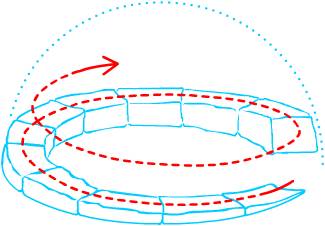 This post surely requires an explanation. Presenting my own work on boiteaoutils can probably interpreted as an hijacking of an information platform and its readers taken in hostage of an autopromotion. However I did feel that criticizing and promoting others' project has a sense for me, only if it was to create a more or less coherent vision of architecture which should be serving my own creation. Therefore, I would like to take the risk of presenting my work as related to this vision.
This post surely requires an explanation. Presenting my own work on boiteaoutils can probably interpreted as an hijacking of an information platform and its readers taken in hostage of an autopromotion. However I did feel that criticizing and promoting others' project has a sense for me, only if it was to create a more or less coherent vision of architecture which should be serving my own creation. Therefore, I would like to take the risk of presenting my work as related to this vision. Spiculation is my diploma project I developped with Martin Le Bourgeois in ESA and I am not presenting it here as an achievement but as a work still in progress. We are currently working on it to make it happen for real, working with polypropylene company and developping it for competitions etc. Valérie Chatelet, our former tutor and author of
Interactive Cities, now joined the team.
Of course your advices and criticism are more than welcome.





Spiculation incarnates an alternative to public space’s hermetism. Its aggregate composes a malleable material which can be transformed at any moment by anybody. The alternative it represents to linked and precise architecture generates a flexible implementation of a fluid material resulting from multitude. In fact, energy it needs to make its shape evolving is very inferior to the one public space’s material needs today. This material comprises intrinsically some qualities based on structure, light filtration and rain evacuation.
However, in order to be colonised, it needs some tools inventions whose conception and fabrication is let to public space actors. Participation principle is simple. Thanks to a manifest to Haptic, only the body’s direct action with its environment provokes a desire’s spatiality.
Spiculation is inspired from Peter Cook’s Instant City, from Bernard Rudofsky’s Architecture without Architects, from R&Sie’s viab in I’ve heard about and from Yona Friedman’s ville spatiale whose it explodes the megastructure then fragment it in order to invade the existing context.
Thanks to a concern not to override its alternative statute, it does not live inside the cartographic public space. In fact spicule is afraid from the “canyon” street, too much directional and too much controlled. It prefers to proliferate inside some heterotopia which are represented by Paris’ interior courtyards and thus to create a wandering network whose absence of control is tacitly accepted by the person who is penetrating into it.
Spiculation's production is also ruled by the in situ logic. The productive machine is invited to live inside the courtyards by adapting itself to their spatiality and functionality. This presence on the site allows the local plastic waste in order to make the spicule’s unique material. Thus, urban material deals with an ambiguous relationship between consumption, waste and its’ production.
Automated fabrication platform is situated several metres above the ground. In the course of production, a spicule tide comes filling this void.
Material finally produced is colonized and used by its actors at the whim of their desires materialising them into a vanishing and manifest device.
Spicules embody thus a constant redefining architecture impossible to plan and whose intrinsic uncertainty makes its control difficult. They are the object of the individual power non delegation and offer its expression to anybody at any moment.
 No matter if we consider past or contemporary self-constructions, those architecture without architects embody a kind of expression of an individual or associative power in the trespassing or not of a local legislation. Their essential motivation often has a vital statute which answer thus more to needs than desires. These needs is then materialized into a shape and a space.
No matter if we consider past or contemporary self-constructions, those architecture without architects embody a kind of expression of an individual or associative power in the trespassing or not of a local legislation. Their essential motivation often has a vital statute which answer thus more to needs than desires. These needs is then materialized into a shape and a space.
















 you want to see up until you get the shape you wanted...
you want to see up until you get the shape you wanted...






























